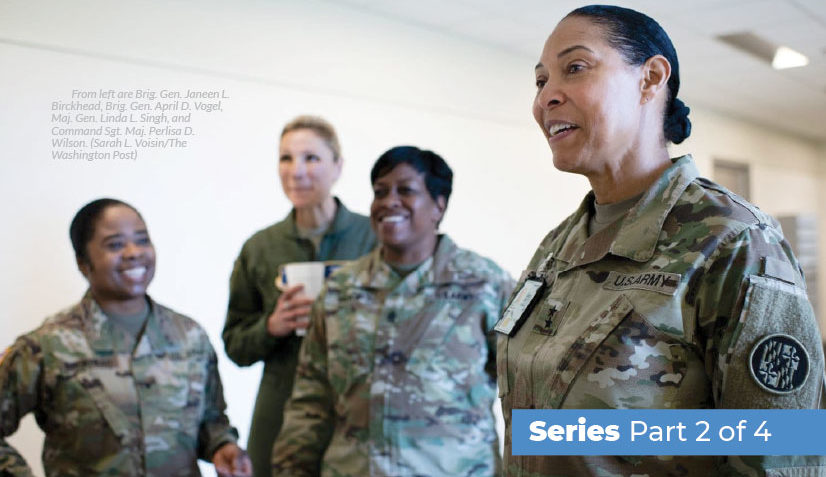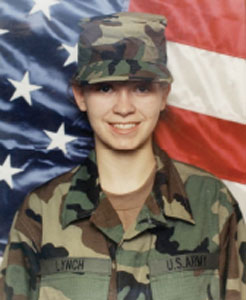A Series by Lishamarie Hunter
We will discuss women taking on more active combat roles in the military throughout the second part of this series. This article will highlight the women who broke barriers and provided the background for the modern female warriors in today’s military, during the Vietnam War, Desert Storm, Iraqi Freedom and throughout Afghanistan War.
1962–1972
During the Vietnam War, over 11,000 women serve, mostly as nurses in all five divisions of the military, Army, Navy, Marines, Air Force and Coast Guard. All were volunteers. There are eight women, seven of these women were Army and one Air Force, who served in the Vietnam war and made the ultimate sacrifice during the service to their country. Their names are inscribed on the Vietnam War Memorial Wall in Washington DC.
1st Lieutenant Sharon Ann Lane, U.S. Army was killed by a rocket explosion on June 8, 1969, less than 10 weeks after she arrived in Vietnam. Assigned to the 312th Evacuation Hospital, 1LT Lane was working in the Vietnamese ward of the hospital when the rocket exploded, killing her and her patients. She was from Ohio and her name can be found on Panel 23, Line 112
2nd Lieutenant Pamela Dorothy Donovan, U.S. Army died of a rare Southeast Asian virus on July 8, 1968. Born in Ireland, she was assigned to the 85th Evacuation Hospital in Qui Nhon. 2LT Donovan is remembered on Panel 53W, Line 43.
Lieutenant Colonel Annie Ruth Graham, U.S. Army suffered a stroke on August 14, 1968. She was from North Carolina and was the Chief Nurse with the 91st Evacuation Hospital in Tuy Hoa. Her name can be found on Panel 48W, Line 12.
Captain Mary Therese Klinker, U.S. Air Force was part of an on-board medical team during Operation Babylift. Her flight was carrying 243 infants and children when it developed pressure problems and crashed while attempting to return to the airport. Captain Klinker was killed on April 4, 1975, just three weeks before the Fall of Saigon. A native of Indiana, she is remembered on Panel 1W, Line 122.
2nd Lieutenant Carol Ann Drazba, U.S. Army was killed in a helicopter crash near Saigon on February 18,1966. Born and raised in Pennsylvania, she is remembered on Panel 5E, Line 46.
2nd Lieutenant Elizabeth Ann Jones, U.S. Army was flying with 2LT Drazba and was killed in the same helicopter crash near Saigon. She was assigned to the 3rd Field Hospital. 2LT Jones was from South Carolina and is remembered on Panel 5E, Line 47.
Captain Eleanor Grace Alexander, U.S. Army had been working in a hospital in Pleiku to help out during mass casualties from Dak To when her plane crashed on the return trip to Qui Nhon on November 30, 1967. She was with the 85th Evacuation Hospital. She was from New Jersey and is remembered on Panel 31E, Line 8.
1st Lieutenant Hedwig Diane Orlowski, U.S. Army was on board with Capt. Alexander when their plane crashed on its return trip to Qui Nhon. She was assigned to the 67th Evacuation Hospital, 1LT Orlowski was from Michigan. She is remembered on Panel 31E, Line 15.
These eight women embodied courage, selfless service and sacrifice. They are American heroes who volunteered to serve their country. They joined the over 265,000 American women who served during the Vietnam era. Approximately 11,000 served in Southeast Asia. A small number of women served in civilian capacities, such as the American Red Cross and the USO. More than 50 civilian women died during this conflict. Other women were assigned as physicians, air traffic controllers, intelligence officers, clerks and in other capacities.
1973
The draft (only for males) ends and an all-volunteer military is formed creating opportunities for women.
1976
The first females are admitted to the service academies, U.S. Military Academy at West Point, U.S.Naval Academy at Annapolis, and the Air Force Academy to be trained in military science.
1978
Women in the Navy and Marines are allowed to serve on non-combat ships as technicians, nurses and officers.
1980
The first women graduates from West Point.
1991–1992
During the Persian Gulf War, more than 41,000 women are deployed to the combat zone. Two are taken captive. SPC Coleman and MAJ Cornum were the two female POWs.
1991
Congress authorizes women to fly in combat missions.
1993
Congress authorizes women to serve on combat ships.It wasn’t until November 1993 that the patriotic service of all women was honored in the nation’s capital at the dedication of the Vietnam Women’s War Memorial.
1998
For the first time, women fighter pilots fly combat missions off aircraft carrier in Operation Desert Fox, Iraq.
2000
Captain Kathleen McGrath becomes the first woman to command a U.S. Navy warship. The vessel is assigned to the Persian Gulf.
2003
During the War in Iraq, three Army women become prisoners of war in the first days of the invasion. Jessica Lynch, Shoshana Johnson, and Lori Piestewa.
2004
Colonel Linda McTague becomes the first woman commander of a fighter squadron in U.S. Air Force history.
2005
During the “War on Terror,” Sergeant Leigh Ann Hester becomes the first woman awarded the Silver Star for combat action.
2008
16,000 women are serving in Iraq, Afghanistan, Bosnia, Germany, Japan, and other related areas. It was during this time that woman soldiers worked with the Marines and Infantry as Female engagement Teams (FET), Lioness Teams. Their mission was to listen to women in the communities and gather information male soldier could not collect due to the cultural restraints.
2015
CPT Kristen Griest and CPT Shaye Haver were the first two women to successfully graduate the Ranger school and be awarded the prestigious Ranger Tab. CPT Shaye Haver also, went on to become one of the first female infantry officers. Women are leaders in the Marine Infantry Units, as well.
2019
The Maryland National Guard for the first time in its history has four top leaders are all female. The members are MG Linda Singh, BG Janeen Birckhead, BG April Vogel, and CSM Perlisa Wilson.
Currently, women are serving traditionally held male occupations within all the military services. They are also serving in combat zones and in combat leadership positions. With the opening up of all areas within the military, maybe one day a woman will hold the highest position and lead the strongest military force in the world as the Commander-In-Chief of the United States of America’s Armed Forces.





